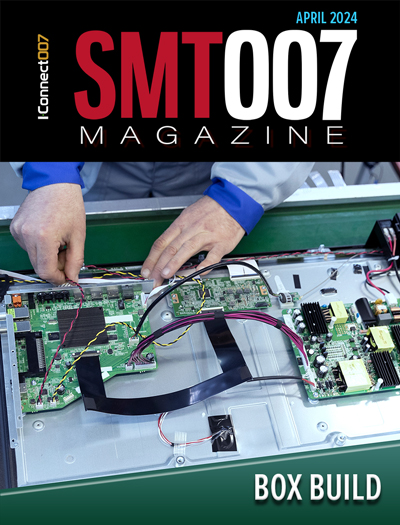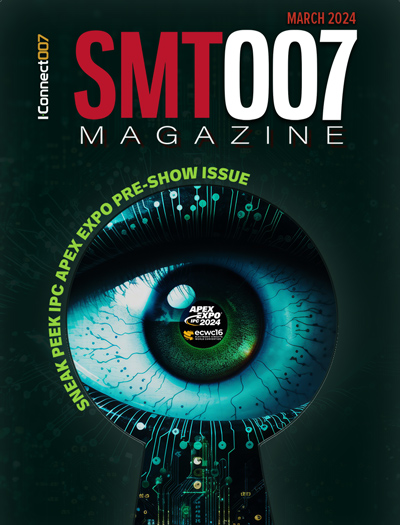-

- News
- Books
Featured Books
- smt007 Magazine
Latest Issues
Current Issue
Coming to Terms With AI
In this issue, we examine the profound effect artificial intelligence and machine learning are having on manufacturing and business processes. We follow technology, innovation, and money as automation becomes the new key indicator of growth in our industry.

Box Build
One trend is to add box build and final assembly to your product offering. In this issue, we explore the opportunities and risks of adding system assembly to your service portfolio.

IPC APEX EXPO 2024 Pre-show
This month’s issue devotes its pages to a comprehensive preview of the IPC APEX EXPO 2024 event. Whether your role is technical or business, if you're new-to-the-industry or seasoned veteran, you'll find value throughout this program.
- Articles
- Columns
Search Console
- Links
- Events
||| MENU - smt007 Magazine
Experience is Key
October 2, 2015 | Stephen Las Marias, I-Connect007Estimated reading time: 2 minutes
One of the leading EMS providers worldwide, Sanmina Corp., has over 20 years of automotive electronics manufacturing experience. The company is fully compliant with all regulatory standards including TS 16949, advanced product quality planning (APQP); product part approvals (PPAP); process failure mode & effects analysis (PFMEA); design failure mode & effects analysis (DFMEA; and part change notice (PCN), and incorporates stringent manufacturing and quality procedures based on lean manufacturing, Six Sigma and zero-defect initiatives.
In an interview with I-Connect007's Stephen Las Marias, Sanmina's Bernd Enser, VP of Global Automotive, discusses the impact of the latest development trends in cars today on the automotive electronics assembly space, as well as the qualifications required of an EMS provider to get into an automaker's AVL. He also explains why experience is essential to becoming successful in the automotive electronics space, and offers his outlook for the industry.
Stephen Las Marias: How has the automotive electronics industry evolved over the past decade, and what major changes have you witnessed?
Bernd Enser: Today's automobiles have far more functionality and advanced electronics than they did 10 years ago. Many areas have been impacted including safety, passenger comfort, driver experience, energy saving, and CO2 reduction. The technology we use in our living rooms and other places such as infotainment, tablets and GPS has been introduced to the car. Advanced functions such as parking assistance and collision-avoidance systems have been incorporated.
These designs require Internet access and other connectivity to provide the mechanisms to identify and sense other vehicles and buildings. And with the introduction of hybrid cars, electronics are needed to optimize energy efficiency.
Las Marias: How does Sanmina help automotive electronics customers ensure high-reliability in their products?
Enser: Sanmina has invested in equipment such as AOI, solder paste inspection (SPI), and AXI, as well as high-speed, high-accuracy pick-and-place machines, reflow ovens and best-in-class printers in order to accommodate the complexity and durability required from sophisticated automotive manufacturing. Feature sets in the new equipment intended to support increased factory automation such as software protocols and machine-to-machine interfaces are carefully reviewed within the context of all the regulatory requirements of TS 16949.
Some of the newer features not only advance the capability to place the more complex fine pitch devices now being included in automotive electronics, they also provide features which enable greater traceability and efficiency and more robust manufacturing.
Experience is the key. Expertise in the technology, applications, processes and applicable supply chains is crucial in a manufacturing environment where OEMs require zero defects from EMS providers. Sanmina pioneered the use of pin-in-paste technology as part of the SMT process for large automotive connectors, which enabled us to reduce cost and improve reliability. We were able to develop this technology by leveraging expertise from other industries.
Editor's Note: This article originally appeared in the September 2015 issue of SMT Magazine.
Suggested Items
Sanmina Appoints Jon Faust as Executive Vice President and Chief Financial Officer
12/06/2023 | SanminaSanmina Corporation, a leading integrated manufacturing solutions company, announced that Jon Faust has been appointed Executive Vice President and Chief Financial Officer, effective December 18, 2023. Kurt Adzema, who previously held this role, will remain with the Company in an advisory capacity until January 5, 2024.
American Made Advocacy: Member Profile on Hari Pillai
12/05/2023 | Travis Kelly -- Column: American Made AdvocacyFor this month's PCBAA Member Profile, the focus is on Hari Pillai, president, Technology Components, Sanmina. Hari says, "I think I’ve had a good dose of luck throughout my career. But beyond luck, I had a vision to become a general manager as far back as my undergraduate years. I made all my career decisions based on that. My evaluation criteria was always, “How does this opportunity get me closer to my goal?” Sometimes opportunities come from unexpected places."
Sanmina Reports Q4, Fiscal 2023 Financial Results
11/07/2023 | SanminaSanmina Corporation, a leading integrated manufacturing solutions company, reported unaudited financial results for the fourth quarter and fiscal year ended September 30, 2023 and outlook for its fiscal first quarter ending December 30, 2023.
Sanmina, Reliance Complete Previously Announced Manufacturing Joint Venture Transaction in India
10/06/2022 | Sanmina Corp.Sanmina Corporation, a leading integrated manufacturing solutions company and Reliance Strategic Business Ventures Limited (RSBVL), a wholly-owned subsidiary of Reliance Industries Limited (RIL), India's largest private sector company, announced they have completed the previously announced joint venture transaction.
Sanmina, Reliance Create Manufacturing Joint Venture in India
03/08/2022 | Sanmina Corp.Sanmina Corporation announced that they have entered into an agreement to create a joint venture through an investment in Sanmina’s existing Indian entity (Sanmina SCI India Private Ltd, “SIPL”).


